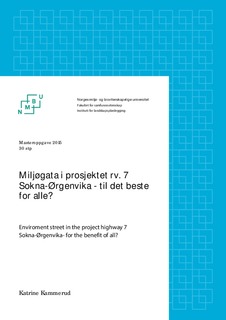| dc.contributor.advisor | Berg, Kristin Marie | |
| dc.contributor.author | Kammerud, Katrine | |
| dc.date.accessioned | 2016-11-23T09:56:09Z | |
| dc.date.available | 2016-11-23T09:56:09Z | |
| dc.date.issued | 2015 | |
| dc.identifier.uri | http://hdl.handle.net/11250/2422632 | |
| dc.description.abstract | Planlegging av større nasjonale veianlegg handler ikke bare om fysisk planlegging, der arealdisponering, standardvalg og hastighet er viktige parameter. Veiplanlegging handler i like stor grad om samfunnsutvikling. Ofte oppstår det konflikter rundt de nasjonale veiprosjektene der de lokale interessene får sterk gjennomslagskraft i løsningene som velges. Dagens planlegging er svak på kravene til hovedvegene som skal binde landet sammen, og dette gjør at lokale hensyn og interesser har mulighet for å vinne fram selv i prosjekter av nasjonal betydning. I Norge til forskjell fra mange andre europeiske land har det overordnede vegnettet flere funksjoner som gjør at veiplanleggingen er blitt et viktig politikkområde for kommunestyrene rundt i Norge. «Riksvegene er hovedpulsårene i det overordnede nasjonale vegtransportsystemet. De forbinder landsdeler og regioner med hverandre og knytter Norge til utlandet. Samtidig har riksvegene viktige regionale og lokale funksjoner.»
Denne masteroppgaven handler om planprosessen som utspiller seg når store nasjonale veiprosjekter utarbeides av staten (Statens vegvesen), mens planprosjektet vedtas av kommunen der veien både har en lokal, regional og nasjonal funksjon. Det er bred politisk og faglig enighet om at det tar for lang tid å planlegge, beslutte og gjennomføre tiltak, men samtidig er det et ønske om at omfattende planlegging skal ivareta kryssende hensyn, og at lokaldemokratiets hensyn skal veies tungt i beslutnings- og planleggingsprosesser. Nasjonale veiprosjekter løper ofte gjennom flere kommuner, og dette skaper en ekstra utfordring når planarbeidet skal samkjøres lokalt. Hvis nasjonale hensyn står i motstrid til de kommunale, og kommuner står imot kommuner blir det en utfordrende prosess.
Jeg har valgt å ta utgangspunkt i et case – miljøgaten gjennom Sokna sentrum, et delprosjekt av riksveg 7 Sokna – Ørgenvika for å belyse spenningsfeltet mellom de nasjonale og regionale/lokale interessene inn i planleggingen av den overordnede infrastrukturen. Det sentrale i min masteroppgave er hvordan planleggerne og forskjellige aktører har påvirket planleggingen og hvordan saksbehandlerne i kommunen som vedtaksmyndighet har agert i deres oppgaveløsning i forhold til disse aktørene. Et annet sentralt omdreiningspunkt i oppgaven er en vurdering av hvilken betydning organiseringen av planprosessen har hatt. Ut fra disse betraktningene er jeg kommet fram til følgende problemstilling:
Hvordan påvirker organiseringen av planprosessen og aktørene det endelige planproduktet? - en analyse av miljøgata gjennom Sokna sentrum i prosjektet riksveg 7 Sokna – Ørgenvika. | nb_NO |
| dc.description.abstract | Planning of major national roads is not just about physical planning, where land use, standard choices and speed are important parameters. Road planning is as much about how to develop society. Often conflicts occur around the national road projects where local interests have a strong impact of the solutions chosen. Today's planning is weak on the requirements of the main roads that will bind the country together, and this allows local concerns and interests that have the opportunity to gain ground even in projects of national importance. In Norway, unlike many other European countries, the overall road network has several features that make road planning become an important policy area for municipal councils around Norway. "Highway is the main artery in the overall national road transport. The connecting regions and regions with each other are linking Norway abroad. Meanwhile, state roads have important regional and local features.
This thesis is about the planning process that unfolds when major national road projects drawn up by the State (NPRA), while plan projects adopted by the municipality where the road has both a local, regional and national function. There is broad political and scientific consensus that it takes too long to plan, decide and implement measures, but it is also a desire for comprehensive planning to safeguard conflicting considerations, and that local democracy considerations should be weighed heavily in the decision-making and planning processes. National road projects often runs through several municipalities, and this creates an additional challenge when planned work will be coordinated locally. If the national interest is in conflict with the municipal, and municipalities oppose each other, it will be a challenging process.
I have chosen to base my master degree on a case - the planning of the road project Highway 7 Sokna - Ørgenvika and environmental street through Sokna center to illuminate the tension between the national and regional / local interests into the planning of the overall infrastructure. The essence of my thesis is how planners and various actors have affected the planning and how social workers in the municipality of decision have acted in their assignments in relation to these actors. Another central fulcrum of the task is an assessment of the significance of the organization that the planning process had. Based on these considerations, I have come to the following question: How does the organization of the planning process and the actors influence the final plan product? - An analysis of the environmental street through Sokna center in the project highway 7 Sokna – Ørgenvika. | nb_NO |
| dc.language.iso | nob | nb_NO |
| dc.publisher | Norwegian University of Life Sciences, Ås | |
| dc.rights | Navngivelse-Ikkekommersiell-IngenBearbeidelse 3.0 Norge | * |
| dc.rights.uri | http://creativecommons.org/licenses/by-nc-nd/3.0/no/ | * |
| dc.title | Miljøgata i prosjektet rv. 7 Sokna-Ørgenvika - til det beste for alle? | nb_NO |
| dc.title.alternative | Environment Street in the Project Highway 7 Sokna-Ørgenvika - for the Benefit of All? | nb_NO |
| dc.type | Master thesis | nb_NO |
| dc.source.pagenumber | 56 | nb_NO |
| dc.description.localcode | M-BYREG | nb_NO |

